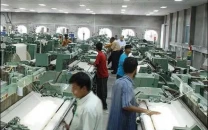Not out of the woods yet
Depreciation in rupee is much worse than 20-year average decline and IMF says it should be devalued further.

PHOTO: FILE
So far, Pakistan has repaid $2.57 billion — including the $145.79 million payment on January 11 and is scheduled to repay another $375 million on February 26.
According to the State Bank of Pakistan, foreign exchange reserves have declined to $8.7 billion as of January 31 from $10.8 billion at the end-June 2012. The IMF has also said that foreign exchange reserves under $10 billion were below adequate levels.
The rupee has recovered slightly from its dip below 100 but it is going to stay under pressure for the foreseeable future and may even set a new record low. The only saving grace is that overseas Pakistani workers have so far remitted $8.21 billion in the ongoing fiscal year, a growth of 10.4 per cent year-on-year. But even this has not been able to save forex reserves from dwindling and registering a 20 per cent decline this year.

The mood of the State Bank of Pakistan, as deduced from the Monetary Policy announcement, is that it won’t be as willing to pump liquidity into the market to prop up the rupee as it has been up till now.
As it is, the fiscal year, so far, has been the worst in a long time. Pakistan rupee depreciation, which fell by 7.8 per cent in 2012 against the US dollar, is higher than most of its peers in the region, as the Indian rupee is down 3.7 per cent against the dollar, while the Bangladeshi taka gained by 1.8 per cent.
The depreciation in the rupee is much worse than the 20-year average decline of 6.2 per cent and the 10-year decline of 3.2 per cent.
There is also pressure from the IMF to devalue the rupee further, saying that it is still over-valued by about five per cent. If the government gives in to that theory, assuming it wants to do whatever is necessary to bring the Fund to the negotiating table, the worst is far from over.
Published in The Express Tribune, February 14th, 2013.



1728020501-0/Express-Tribune-Web-(13)1728020501-0-208x130.webp)







1726134115-0/BeFunk_-(41)1726134115-0-208x130.webp)







COMMENTS
Comments are moderated and generally will be posted if they are on-topic and not abusive.
For more information, please see our Comments FAQ